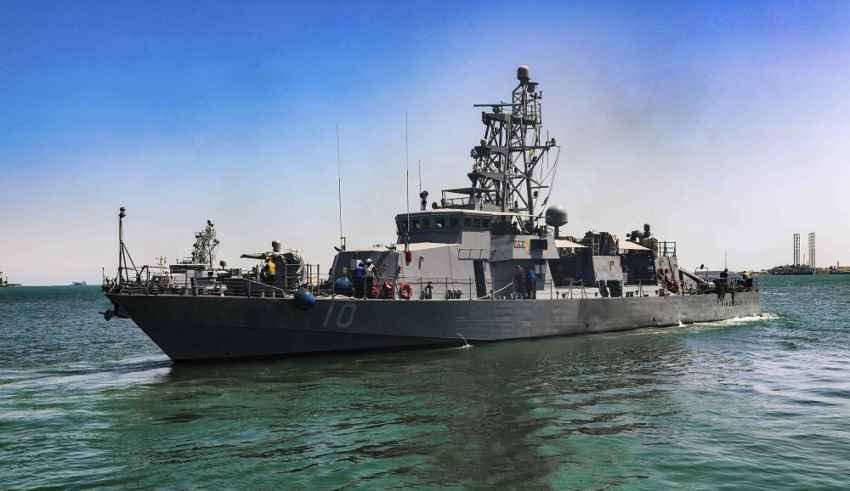
Since the 1980s, Iranian and US naval forces have had intermittent and occasionally violent confrontations. The Islamic Revolutionary Guard Corps (IRCG), not Iran’s regular navy, has been involved in the majority of the confrontations. Many collisions have happened in or around the Strait of Hormuz, through which up to a third of the world’s seaborne oil passes. Exceptionally,The most recent incidents were in November 2021, when small and medium-sized Iranian boats encountered U.S. warships in the Gulf of Oman in multiple interactions. Concerning this issue, The US and Iran offered diametrically opposed accounts of an incident involving a Vietnamese-flagged oil ship in the Gulf of Oman on 3 November 2021 (France 24, 2021). As this issue raised crucial concern and criticism, this article is devoted to address legal aspects of such military encounters.
Background of naval encounters among Iran and US
During the Iran-Iraq War, the first naval confrontations between Iran and the United States had place (1980-1988). Two months after Iraq attacked Iran’s oil station on Kharg Island and numerous Iranian ships, Iran began attacking commercial vessels in the Persian Gulf. The US conducted Operation Nimble Archer (October 1987) and Operation Praying Mantis (October 1988) to defend tankers in the Gulf (April 1988) (USIP,2021).
Between 2004 and 2008, Iran provoked US ships in the Persian Gulf and the Strait of Hormuz at least five times during the Bush administration. After the US invasion of Iraq in 2003, tensions between the two countries were at an all-time high. Six British sailors and two British marines were arrested in 2004 by the IRGC while serving in the Gulf as part of a US-led naval coalition. Following negotiations, they were released (Ibid).
Between 2008 and 2017, Iranian ships collided with US ships in the Persian Gulf and the Strait of Hormuz dozens of times during the Obama administration. Many of the instances occurred during the 2015 Iran nuclear agreement discussions, which were reportedly opposed by some IRGC officials who did not trust Western countries, particularly the United States. Iranian warships allegedly, according to US Central Command, engaged in dangerous and/or unprofessional behavior in nearly 10% of the 300 run-ins with US ships in 2015, or around 30 times (Ibid).
The naval confrontations ceased in August 2017 under the Trump administration. It was, however, restarted in October 2018, five months after Trump withdrew from the 2015 nuclear agreement and reimposed sanctions, although in a more intermittent manner than before (Ibid).
Since Biden’s inauguration in January 2021, Iranian ships had engaged with US ships twice. On April 2, the first incident occurred just four days before indirect discussions between the US and Iran in Vienna on returning to full compliance with the 2015 nuclear deal. The third round of discussions ended on April 26 with the second incident (Ibid).
Recent Confrontation in the Gulf of Oman
The middle east region is still on edge as a result of Iran’s escalating nuclear program. The talks in Vienna to resurrect the Joint Comprehensive Plan of Action (JCPOA) have been stuck since June, with no date set for their restart (France 24, 2021). In this sense, recent confrontation among US and iran naval ships made the region more unstable.
Iran’s elite Revolutionary Guards (IRGC) stated last week that they had prevented a US Navy effort to capture the vessel transporting Iranian oil. The assertion, which made no particular reference to time, was the latest indicator of rising tensions between the two states as hopes for a new agreement on Iran’s nuclear program dwindle (CBS, 2021). However, a US defense official, termed the Iranian statement “inaccurate and untrue,” claiming that two US ships in the region witnessed Iranian forces “swarming, boarding, and seizing the vessel and taking it to Iranian waters”(France 24, 2021).
The event underlines the increasingly tense situation in both the physical waterways that carry much of the world’s oil supplies and the political standoff between Tehran and the West over the country’s nuclear program (CBS, 2021).
Legal aspects of naval confrontations
Since 1979, no US-Iran confrontation has led to a military conflict between the two countries. However, such a collision has been on the verge of occurring. As a result, Iran considers the presence of US warships in Iranian territorial waters, the Persian Gulf, and the Gulf of Oman, to be a threat to its national security (Bagheri,2016) .
In this sense, although the tension was not raised to the level of an armed conflict, it is important to address the concept of “Naval warfare” which is relevant to this recent incident. from the perspective of international law, Naval warfare is the term used to denote “the tactics of military operations conducted on, under, or over the sea”. The general principles of International Humanitarian Law applicable to armed conflicts on land apply to this type of military operations as well. Naval warfare nevertheless has certain singular features that necessitate a specific set of rules.
In other words, All armed confrontations are subject to the core laws and principles of international humanitarian law, regardless of whether they take place on land, sea, or air. Nonetheless, many features of naval and aerial combat are particularly mentioned in treaties and customary law.
Until World War I, war at sea had been governed primarily by the Hague treaties and customary law. However, the means and methods of warfare during that conflict, in particular the use of submarines and attacks on neutral shipping, raised questions about the application of IHL. In World War II arbitrary attacks on hospital ships and Red Cross vessels carrying relief supplies again raised the issue of whether the balance between military and humanitarian needs in customary naval law was being respected(ICRC,2010).
Questions of civilian safety, the use of blockades and exclusion zones at sea continued to be raised in the naval wars in the Falklands/Islas Malvinas, in the Iran-Iraq war and the Gulf war. However, no new major treaty governing naval war was considered by the international community. Instead, non-binding guidelines, namely the San Remo Manual of 1994 was drawn up by government and other experts, the ICRC and a number of National Societies. The Manual essentially reaffirmed and updated the interpretation of IHL as applied to war at sea(ibid).
It explains the application of the principle of distinction at sea, which is based on Additional Protocol I to the Geneva Conventions, which was adopted in 1977. This entails defining a military objective. Warships, as well as auxiliary vessels and commerce ships that directly aid the enemy’s military activity, are military targets. The Manual includes a list of behaviors that might turn a non-military vessel into a valid military target. Mine laying, troop carrying, intelligence gathering, sailing under military convoy, resisting stop and search, and carrying significant armament are all instances (ibid).
Similarly, the Manual specifies certain ships may not be targeted, such as hospital ships, coastal rescue craft, vessels carrying prisoners of war, passenger vessels carrying only civilians, coastal fishing craft, and lifeboats. The Manual focuses largely on the implementation of international humanitarian law at sea during armed conflict. The 1982 Convention on the Law of the Sea addresses more general legal issues of public international law. The Manual does, however, restate that IHL cannot be waived in situations where it is applicable, such as exclusion zones. Also, naval operations must avoid causing needless environmental harm to land or water, as well as depriving civilian populations of their means of existence. IHL also protects cultural assets against naval attack(ibid).
To conclude, the recent confrontation among the US and Iran naval forces over the a Vietnamese oil tanker was the latest provocation in Mideast waters. Although both forces had not carried out any military action against each other, it must be bear in mind that such encounters might escalate in a way that IHL rules would be applicable.
Bibliography
France 24, 2021, “US, Iran dispute facts of tanker incident in Sea of Oman”, accessed 5 November 2021 < https://www.france24.com/en/live-news/20211103-us-iran-dispute-facts-of-tanker-incident-in-sea-of-oman >.
USIP, 2021, “Timeline: U.S.-Iran Naval Encounters”, accessed 5 November 2021 < https://iranprimer.usip.org/blog/2021/may/05/timeline-us-iran-naval-encounters >.
CBS, 2021, “U.S. denies Iran’s claim that American Navy attempted to “steal” a tanker full of oil”, accessed 6 November 2021 < https://www.cbsnews.com/news/iran-us-oil-tanker-attempt-to-steal-thwarted-tehran-claims/ >.
ICRC,2010, “Air and naval warfare”, accessed 7 November 2021 < https://www.icrc.org/en/document/air-naval-warfare >.
Bagheri, Saeed. (2016). Iran-U.S. Confrontation in the Persian Gulf: An International Law Perspective. Foreign Policy Association.
By The European Institute for International Law and International Relations.














